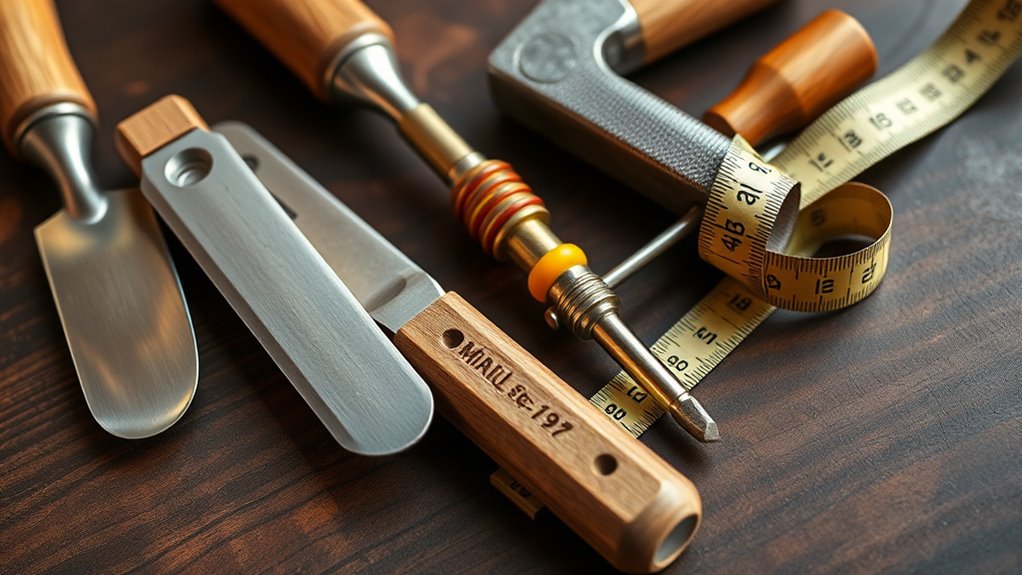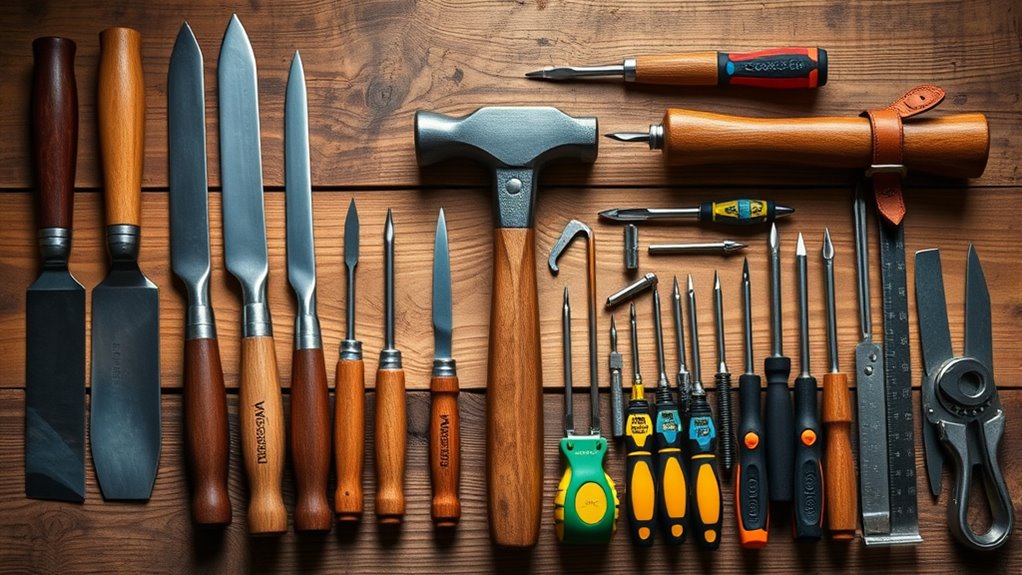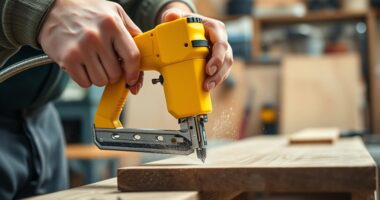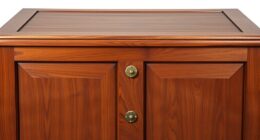A basic hand tool kit for woodworking should include essential items like a hammer, screwdrivers, measuring tape, hand saws, and chisels for precise cuts and joints. Guarantee you also have a square and level for accurate assembly, along with safety gear such as glasses and gloves. Keeping tools well-maintained ensures safety and quality. To build a reliable collection that boosts your skills, explore more features of a well-rounded toolkit.
Key Takeaways
- A comprehensive set including hammer, screwdrivers, measuring tape, hand saws, and chisels covers most basic woodworking needs.
- Essential measuring and alignment tools like squares and levels ensure accurate cuts and proper project alignment.
- Safety gear such as safety glasses and gloves protect against injuries during hand tool use.
- Maintaining sharp blades and well-maintained tools improves safety, efficiency, and quality of work.
- Combining hand tools with power tools enhances precision, speed, and versatility in woodworking projects.

Have you ever wondered what tools are truly essential for tackling everyday repairs and projects? When it comes to woodworking, having the right hand tools can make all the difference. A well-rounded kit saves you time, guarantees safety, and helps you achieve professional results. While power tools are fantastic for speed and efficiency, your basic hand tools are indispensable for precision work, detail tasks, and when power tools aren’t practical. Before diving into your projects, it’s crucial to equip yourself with the essentials, including safety gear, to protect yourself from potential hazards.
Start with the basics: a hammer, screwdrivers, and a measuring tape. A sturdy claw hammer is versatile for driving nails and removing old fasteners. Screwdrivers, both flat-head and Phillips, are necessary for assembling furniture, adjusting fixtures, or installing hardware. A reliable measuring tape ensures your cuts and placements are accurate, preventing costly mistakes. These tools form the foundation of any woodworking kit and are easy to carry around, making them perfect for quick fixes or detailed projects. Additionally, understanding hand tool safety is vital to prevent accidents and work efficiently with confidence.
Start with a hammer, screwdrivers, and a measuring tape for essential woodworking tasks.
Don’t forget a good set of hand saws—like a crosscut and a rip saw—to handle cutting tasks where power saws might be too cumbersome or unnecessary. A set of chisels is also essential for fine woodworking, carving, or fitting joints. These tools require a sharp blade and proper technique to work effectively, so keep them well-maintained. Additionally, a square and level will help you ensure your projects are perfectly aligned and straight, which is vital for both aesthetics and structural integrity.
While power tools are a huge boost for larger or repetitive tasks, they shouldn’t replace the tools in your hand kit. They complement each other, making your work more efficient. Always prioritize safety gear when working with any tools. Safety glasses protect your eyes from flying debris, while gloves safeguard your hands during heavy-duty tasks. Hearing protection is also wise when using loud power tools, even if you prefer working with hand tools most of the time. Wearing the right safety gear not only prevents injuries but also boosts your confidence, letting you work more comfortably and efficiently.
Frequently Asked Questions
How Do I Choose the Right Hand Tools for My Skill Level?
To choose the right hand tools for your skill level, start by considering tool material—opt for durable options like steel for longevity. Look for ergonomic design to guarantee comfort and control as you work, especially if you’re a beginner. As your skills grow, upgrade to more advanced tools. Focus on quality over quantity, and select tools that match your current projects to develop confidence and improve your craftsmanship.
Are There Budget-Friendly Hand Tools That Still Offer Quality?
Yes, there are affordable options that still offer quality for your hand tools. Look for reputable brands known for durability and performance, and consider buying used tools or sets that give you good value. Pay attention to quality considerations like comfortable grips, sharp edges, and sturdy construction. This way, you get reliable tools without breaking the bank, ensuring your projects are successful and enjoyable.
How Often Should I Replace or Upgrade My Hand Tools?
You should replace or upgrade your hand tools when they show signs of wear or damage that affect their performance. Regular tool maintenance, like cleaning and sharpening, helps extend tool longevity. Keep an eye on your tools, and don’t hesitate to upgrade when they no longer perform well or become unsafe. Proper care guarantees your tools stay effective, making your woodworking projects smoother and more enjoyable over time.
What Safety Precautions Should I Take When Using Hand Tools?
When using hand tools, always wear protective gear like gloves and safety glasses to prevent injuries. Keep your tools in good condition through regular tool maintenance, making sure blades are sharp and handles secure. Focus on proper technique, cutting away from your body, and staying alert to avoid accidents. These precautions help protect you and ensure precise, safe woodworking, making your projects enjoyable and injury-free.
Can I Customize My Hand Tool Kit for Specific Projects?
Absolutely, you can customize your hand tool kit for specific projects by focusing on the tools you’ll need most. Use tool storage solutions like labeled containers or a portable toolbox to keep everything organized. Implement organizational tips such as grouping similar tools together and maintaining a dedicated space for each. This way, your kit stays efficient, and you can quickly access the right tools for any project, saving you time and effort.
Conclusion
Now, as you finally gather your essential hand tools, you’ll notice how each piece fits perfectly into your woodworking journey. It’s almost like the tools were waiting for you to start, ready to bring your projects to life. With the right kit in hand, you’re all set to create, repair, and craft with confidence. So, pick up those tools—you never know what incredible projects await just around the corner.









